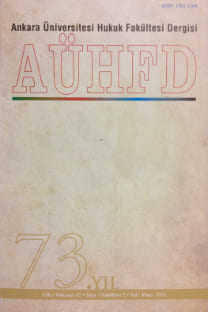The Evaluation Of Macroeconomic Impact Of Free Zones: Turkey Case
Geçmişi iki bin yıl önce Anadolu topraklarında kurulmuş olan serbest ticaret bölgelerine dayanan serbest bölgelerin modern örneklerinin kuruldukları ülkelerin ekonomilerine yaptıkları katkılar; son kırk yıldır bilimsel araştırmalara konu olmaktadır. Ülkemizde de 1988 yılından itibaren kurulmaya başlanan serbest bölgelerin sayısı geçen yirmi yılda, yirmiye ulaşmıştır. Bu çalışmada ülkemizdeki serbest bölgelerin, ekonomiye katkısı, kuruluş yeri teorisinin temelleri ışığında ve dünya serbest bölge uygulamalarının sonuçlarıyla karşılaştırılarak incelenmeye çalışılmıştır
Anahtar Kelimeler:
Serbest Bölgeler, kuruluş yeri teorisi, makro ekonomik etkiler
The Evaluation Of Macroeconomic Impact Of Free Zones: Turkey Case
The macroeconomic impact of the free zones on host countries has been investigated for the last four decades. Free zones, having existed in the very ancient cities of Anatolia in 1900 BC, are as old as the Western civilizations. Over the two millennia, they have evolved into a quite different form in comparison to the free zones of the past. Although they still mainly serve the purpose of organizing free trade between different countries, the modern free zones deal with a complex and dynamic environment in the globalized world economy. Even though it is not certain that all parties benefit from all trade, as far as developing countries are concerned, it is certain that it would not be possible to improve their welfare without participating in the world trade system
Keywords:
Free Zones liberalization, delocalization, macro economic impact,
___
- Alonso, William, Location Theory and Land Use, Harvard University Press, Cambridge, Massachusetts, 6th. Print.,1977.
- Alonso, William, “Location Theory”, Regional Policy Readings in Theory and Applications, Edited by John Friedman and William Alonso, MIT Pres, Cambridge, Massachusetts and London, England, 2nd. Print., 1978, s.35-63.
- Alonso, William, “Industrial Location and Regional Policy in Economic Development” Applications, Edited by John Friedman and William Alonso, MIT Pres, Cambridge, Massachusetts and London, England, 2nd. Print., 1978, s. 622-635. Policy Readings in Theory and
- Alpar, Cem, Az Gelişmiş Ülkelerin Dış Ticaret Sorunları ve Sanayileşme, A.İ.T.İ.A. Yayını, Ankara,1982.
- Baissac, Claude, “A Critique of Cost-Benefit Analysis in the Evaluation of Export Processing Zones”, WEPZA Round Table on EPZs , Vienna, 4/15/1996.
- Baissac, Claude, “Maximising the Developmental Impact of EPZs: A Comparative Perspective in the African Context of Needed Accelerated Growth”, A Presentation at the Johannesburg EPZ Symposium, October 15-16 2003.
- Başkaya, F. Borç Krizi Üzerine Bir Deneme, Birlik Yay., Ankara, 1986.
- Başkaya, Fikret, Az Gelişmişliğin Sürekliliği, Kaynak Yayınları, İstanbul, 1986.
- Bagwhati, J., Trade and Empoyment in Developing Countries, Chicago University Press, 1982.
- Becman, Martin, Location Theory, Random House,1968.
- Bolin, Richard L., “Why Export Processing Zones Are Necessary”, WepzaWebsite: http: //www.wepza.org.
- Da Ponte John J.Lr., “United States Foreign-Trade Zones: Adapting to Time and Space”, The Maritime Lawyer, Vol.V, No.2 Fall 1980, s.198.
- Denis, Henri, Ekonomik Doktrinler Tarihi, C.I- II, Sosyal Yay., İstanbul, 1974.
- Greenhut, M.L., Plant Location in Theory and Practice, Chapel Hill, N.C. University of North Carolina Press, 1956.
- Hamada, K., “An Economic Analysis of the Duty-Free Zone”, Journal of International Economics, 4/3, s.225-241.
- Haywood ,Robert, “Developing Trade Capacity Through Free Zones”, World Economic Processing Zones Association, December 3, 2003, Casablanca, Morocco.
- Haywood Robert, “Using Trade Preferences to Promote EPZ Development”, Speech at World Free Zone Convention, Cairo, Egypt, April 27, 2004.
- Hoover, Edgar M., Location Theory and Shoe and Leather Industries,Cambridge, Mass.,1937.
- Isard vd., General Theory Social, Political, Economic and Regional With Particular Reference to Decision-Making Analysis/Methods of Regional Analysis : an Indroduction to Regional Sciences, MIT Pres, Cambridge, Mass, 1969.
- Isard, W. Introduction to Regional Science, Prentice-Hall, Inc. Englewood Cliffs New Jersey, 1975.
- Isard, Walter., Location and Space Economy, The M.I.T. Pres Cambridge, Massachusetts, 4th.Print.Sept. 1965.
- Karaska, G.F./Bramhall, D.F., Location Analysis for Manufacturing A Selection of-Readings, The MIT Pres 3 rd.print.July 1975.
- Kindelberger, C., International Economics, Richard D. Irwin,Inc., Homewood Illionis, 3 rd. ed. 1963.
- Kocaman, Berna, Serbest Bölgeler, Siyasal Kitabevi,Ankara, 2003.
- Krueger, Anne O., Liberalization Attempts and Consequences, Cambridge, Mass. Ballinger, 1977.
- Krueger, Anne O., “The Political Economy of Rent-seeking Society”, American Economic Review 64, No. 5 (June 1984), s. 291-303.
- Luther, Ulrich Hans, Güney Kore Bir Model Olabilir mi?, Çev. Erol Özbek, Belge Yayınları, İstanbul, 1984.
- Mc Kinnon, R.I., Money and Capital in Economic Development, Washington D.C., Brooking, 1973.
- Mutti John, “Economic Processing Zone: Removing Trade and Tax Obstacles to Growth”, WEPZA 25th. Birthday Conference, İstanbul, Turkey, October 21, 2003.
- Portant, François, Kalkınmanın Sonu, Çev. F. Başkaya, Birey ve Toplum Yay.,Ankara 1985.
- Ramstad, Yngve, “Free Trade versus Fair Trade: Import Barries As a Problem of Reasonable Value”, Journal of Economic Issues, Vol. XXI, No. 1, March 1987, s. 5 - 32.
- Reed, Ruddel Jr., Plant Location, Layout and Maintanence, Richard D. Irwin Inc. Homewood, Illinois, 1967.
- Samulelson, P.A., Economics: An Introductory Analysis, New York Mac Graw-Hill: 1964.
- Tekeli, İlhan, Mekan Organizasyonlarına Makro Yaklaşım (Türkiye Üzerine Bir Deneme), Ankara,1979.
- Tekeli, İlhan/İlkin Selim, Dünyada ve Türkiye’de Serbest Üretim Bölgelerinin Doğuş ve Dönüşümü, Yurt Yayınları, Ankara,1987
- UNIDO, World Industry in 1981.
- Weber,A., Theory of the Location of Industries, Çev. C. Friedrich, The University of Chicago Pres, 3rd. print, 1958.
- ISSN: 1301-1308
- Yayın Aralığı: Yılda 4 Sayı
- Başlangıç: 1943
- Yayıncı: Ankara Üniversitesi Hukuk Fakültesi
Sayıdaki Diğer Makaleler
ÖZEL MÜLKİYET HAKKININ TEMELİ OLARAK EMEK
Economic Criteria of The European Union
KAN LEKELERĐNE ETKİ EDEN ÇEVRESEL FAKTÖRLER
Nihal AÇIKGÖZ, Özer KENDİR, Yaşar BİLGE
The Assessment of the Article 63 of the Public Procurement Act in the Perspective of EU Law
The Evaluation Of Macroeconomic Impact Of Free Zones: Turkey Case
